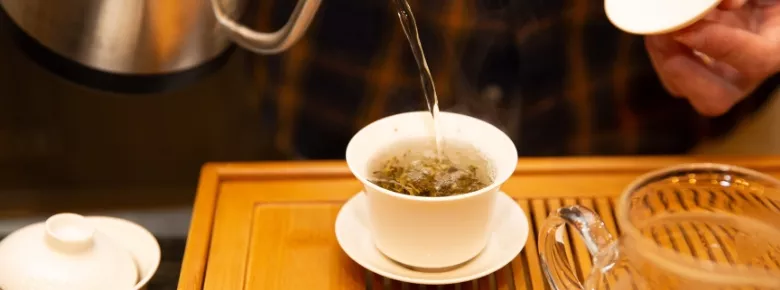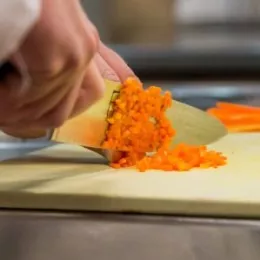For a tea that has been around for thousands of years in China — originating along The Silk Road and dating back to the Eastern Han Dynasty — Pu’er remains a unique and sought after tea in both eastern and western markets.
Reaching peak popularity in the Qing Dynasty, it continues to be a desired tea for its ease of transport and ability to improve with age. Through a tasting of eight Pu’er tea varietals, Rishi Tea & Botanicals treated us to an informative presentation on the history & processing of Pu’er tea and best practices for tea buying, storing and brewing.

The Unique Aging of Pu’er Tea
Over the years of harvesting Pu’er farmers found that the leaves improved as the tea fermented with time, or fermented through the roasting process, which increased its popularity. The aging capabilities of the tea trees deep in the jungles where Pu’er is found also impacted the desire for the tea. Some trees are said to be thousands of years old and still produce a great amount of leaves. Unlike grape vines that yield less grapes as they age, tea trees maintain their ability to yield a solid amount of leaves thousands of years later.
 Pu’er belongs to the category of “dark teas” in the west, and “black teas” in China. It can be confusing as teas that are considered “black teas” in the west are actually referred to as “red teas” in China. It’s clear though that Pu’er is best categorized in the dark tea group as these teas are also known as “aged,” “vintage” or “post-fermented.”
Pu’er belongs to the category of “dark teas” in the west, and “black teas” in China. It can be confusing as teas that are considered “black teas” in the west are actually referred to as “red teas” in China. It’s clear though that Pu’er is best categorized in the dark tea group as these teas are also known as “aged,” “vintage” or “post-fermented.”
Harvesting & Processing Pu’er Tea
 Pu’er tea can be made and categorized in two different ways, but it must be from the large-leaf Assamica variety of the Camellia sinensis tea plant and made in the Yunnan province of China to be named Pu’er. The Sheng category of Pu’er means that the tea is “green,” “raw,” or “uncooked.” The second category, Shou, is also known as “black,” “cooked,” or “ripened.” Both of these will go through the normal tea production process of picking the leaves, rolling & forming by hand or machine, sun-drying, steaming, and shaping the leaves.
Pu’er tea can be made and categorized in two different ways, but it must be from the large-leaf Assamica variety of the Camellia sinensis tea plant and made in the Yunnan province of China to be named Pu’er. The Sheng category of Pu’er means that the tea is “green,” “raw,” or “uncooked.” The second category, Shou, is also known as “black,” “cooked,” or “ripened.” Both of these will go through the normal tea production process of picking the leaves, rolling & forming by hand or machine, sun-drying, steaming, and shaping the leaves.
The only difference between the two categories is that Shou has an extra step of “cooking” the leaves, which means to pile them and help in the fermentation process. This process breaks down the enzymes naturally, which creates heat and helps to “cook” the leaves, in turn adding a different dimension to each cup of tea.
 After the entire process is completed for either category, the tea leaves can be left as loose leaves or shaped into different forms — most commonly a tea cake — which makes it easier to transport. After 3 months, Pu’er tea can be brewed for drinking, but additional years of aging will allow the tea to develop its uniquely aged flavor.
After the entire process is completed for either category, the tea leaves can be left as loose leaves or shaped into different forms — most commonly a tea cake — which makes it easier to transport. After 3 months, Pu’er tea can be brewed for drinking, but additional years of aging will allow the tea to develop its uniquely aged flavor.
Similarly to the importance of terroir for wine, each cup of tea reflects the terroir of where it came from. Terroir can greatly impact flavor in tea as tea leaves soak up anything from its environment. When it comes to Pu’er tea, each farmer and estate has a different way of producing the tea based on millennium old traditions, location, harvest time, how long the leaves were “cooked” for — or if they were at all — and so on. The aging and fermentation process can also impact the flavor and impart different depths to each cup and brew of tea. Tea leaves are sensitive to any change in environment, so anything can really impact the flavor of the tea.
Tips to Buying, Storing and Brewing Your Pu’er Tea
Buying your tea from a trusted source is vital to the quality and consistency of Pu’er tea. Similarly to how Champagne can only come from one region in France, only Pu’er tea from the Yunnan province can be called Pu’er. It’s important to buy from a source that is trustworthy in order to ensure that what you are buying is actually Pu’er.
It is also extremely important to purchase organically made teas. In the same way that the quality is vital, organically made teas are shockingly harder to find, but necessary. As tea can (and does) soak up anything from its environment, if the tea is not organic, it will absorb pesticides and harmful substances that is then brewed directly into your cup.
Storing your Pu’er tea in a cool, odor free and dry location will prolong the life and quality of your tea. Leaving your tea exposed to air is harmful to the tea and can make it oxidize faster — although this can add flavor, it will shorten your tea’s life — so be sure to repackage your tea after each use. It is also important not to touch the leaves frequently with your hands — using a tea pick or a measuring spoon is best practice.
Each Pu’er tea that you buy will be different, so the temperature to brew, steep time, and so on will vary. When brewing your Pu’er tea, consult with your tea shop beforehand to brew correctly.
 A special thanks to Rishi Tea & Botanicals for sharing their vast knowledge on Pu’er Tea. They are the largest importer of certified organic specialty Green, White, Black and Pu’er teas from Yunnan, China in the USA, so be sure to check out their online store here.
A special thanks to Rishi Tea & Botanicals for sharing their vast knowledge on Pu’er Tea. They are the largest importer of certified organic specialty Green, White, Black and Pu’er teas from Yunnan, China in the USA, so be sure to check out their online store here.
Read more about tea from a tasting event at ICE's LA campus.
This blog post was originally published by the International Culinary Center (ICC), founded as The French Culinary Institute (FCI). In 2020, ICE and ICC came together on one strong and dynamic national platform at ICE's campuses in New York City and Los Angeles. Explore your culinary education where the legacy lives on.



